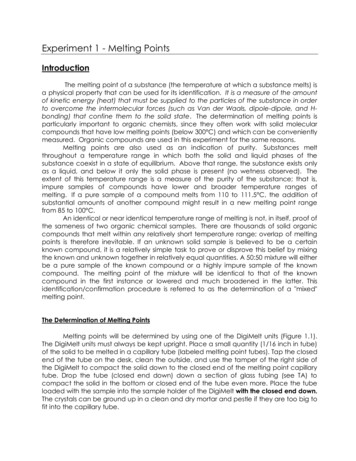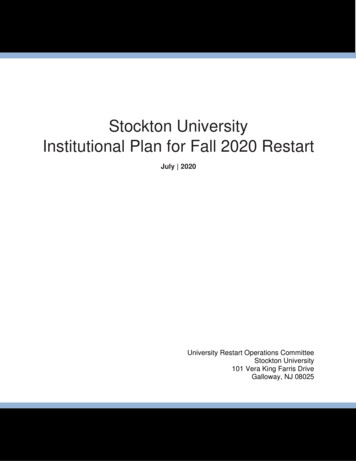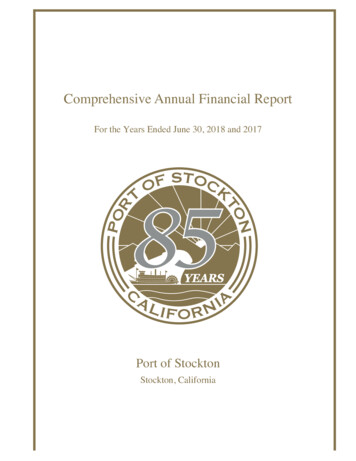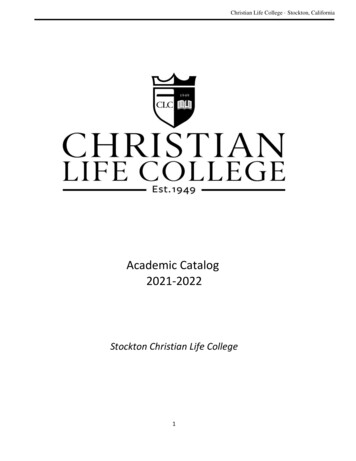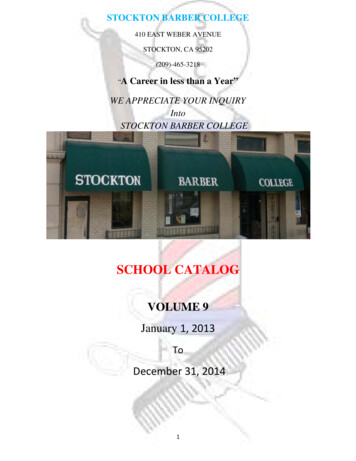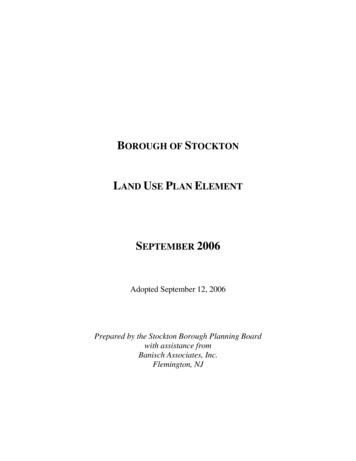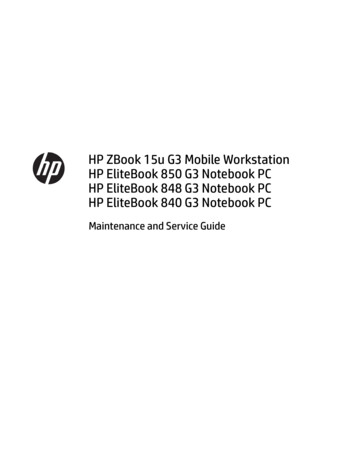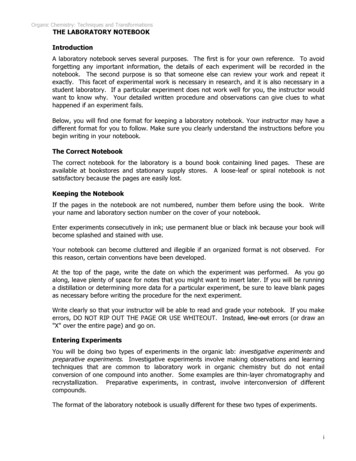
Transcription
Organic Chemistry: Techniques and TransformationsTHE LABORATORY NOTEBOOKIntroductionA laboratory notebook serves several purposes. The first is for your own reference. To avoidforgetting any important information, the details of each experiment will be recorded in thenotebook. The second purpose is so that someone else can review your work and repeat itexactly. This facet of experimental work is necessary in research, and it is also necessary in astudent laboratory. If a particular experiment does not work well for you, the instructor wouldwant to know why. Your detailed written procedure and observations can give clues to whathappened if an experiment fails.Below, you will find one format for keeping a laboratory notebook. Your instructor may have adifferent format for you to follow. Make sure you clearly understand the instructions before youbegin writing in your notebook.The Correct NotebookThe correct notebook for the laboratory is a bound book containing lined pages. These areavailable at bookstores and stationary supply stores. A loose-leaf or spiral notebook is notsatisfactory because the pages are easily lost.Keeping the NotebookIf the pages in the notebook are not numbered, number them before using the book. Writeyour name and laboratory section number on the cover of your notebook.Enter experiments consecutively in ink; use permanent blue or black ink because your book willbecome splashed and stained with use.Your notebook can become cluttered and illegible if an organized format is not observed. Forthis reason, certain conventions have been developed.At the top of the page, write the date on which the experiment was performed. As you goalong, leave plenty of space for notes that you might want to insert later. If you will be runninga distillation or determining more data for a particular experiment, be sure to leave blank pagesas necessary before writing the procedure for the next experiment.Write clearly so that your instructor will be able to read and grade your notebook. If you makeerrors, DO NOT RIP OUT THE PAGE OR USE WHITEOUT. Instead, line out errors (or draw an"X" over the entire page) and go on.Entering ExperimentsYou will be doing two types of experiments in the organic lab: investigative experiments andpreparative experiments. Investigative experiments involve making observations and learningtechniques that are common to laboratory work in organic chemistry but do not entailconversion of one compound into another. Some examples are thin-layer chromatography andrecrystallization. Preparative experiments, in contrast, involve interconversion of differentcompounds.The format of the laboratory notebook is usually different for these two types of experiments.i
Organic Chemistry: Techniques and TransformationsNotebook Format for Investigative Experiments1.Aim. Give a brief aim of the experiment in which you clearly state the purpose(s) of theprocedure. This should require no more than one-fourth of a page.2.Apparatus Required. List all the apparatus you might require to carry out yourexperiment.3.Theory or Principle. State the fundamental idea behind doing an experiment. Forexample, if your goal is to separate a mixture, then state the principle behind the separationwhether the separation technique is based on difference in solubility, or difference in boilingpoint, etc.4.Table of Reagents. Whenever you use chemicals, include a table of reagents that liststhe name, structure, molecular formula, molecular weight, melting/boiling points, density andquantity used (in g or mL as well as in moles) for each chemical you will use. For investigativeexperiments, you do not need to put in the amount of chemicals used, as it may be somethinglike “1 drop”.5.Procedure. List the steps involved in carrying out the experiment briefly, in points or byusing a flow chart. Do not copy the experimental procedure from the book but provide asynopsis of it.6.Observations. Enter a one- or two-line statement for each part of an experiment.Reserve sufficient room to record results as they are obtained.7.Discussion of Results: Summarize your results and present your inferences based onyour results and observations.8.Conclusions. Record the conclusions that can be reached based on the results you haveobtained in the experiment. If the procedure has involved identification of an unknowncompound, summarize your findings in this section.A sample write-up of an investigative experiment is given below.Al KaneFeb. 1, 2010Separation of Green Leaf Pigments by TLCReference: Organic Experiments by Fieser and Williamson, Section 9.2.AIM: The pigments in green leaves are to be extracted into an organic solvent, and theextract is to be analyzed by thin-layer chromatography (TLC).APPARTUS REQUIRED: TLC Plates, TLC capillaries, TLC chamber, RulerTHEORY: Thin layer chromatography is a method of separation of a mixture based ondifference in polarities of the individual components making up the mixture. Thepresence of multiple spots on the developed TLC plate will indicate that more than aii
Organic Chemistry: Techniques and Transformationssingle pigment is contained in the leaves. The Rf value is calculated as the ratio ofdistance moved by the solute to the distance moved by the developing solvent, and isindicative of the relative polarities of the individual components. Lower the Rf value,higher the polarity and vice versa.TABLE OF REAGENTS:NameMol. Formula, struc.Mol. weightm.p/b.p oCDensity g/mLAmountusedmolesFill in all the reagents you will be using and include the appropriate properties alongwith the amounts you will be using.PROCEDURE: Grind 5 spinach leaves in mortar and pestle with 5 mL of 2:1 pet. etherand EtOH. Swirl soln. with 3 x 2 mL portions of H2O in sep. funnel; dry org. soln. forfew min over anhyd. Na2SO4 in Erlenmeyer. Decant and concentrate soln. if not darkcolored. Spot 10 cm x 2 cm TLC plate about 1.5 cm from end with dried extract; spotshould be less than 2 mm diam. Develop plate with CHCl3.OBSERVATIONS AND RESULTS:Procedure followed exactly as described in reference. Org. soln. was dark green incolor; aq. extracts were yellowish. Half of org. layer lost. TLC plate had five spotshaving colors and Rf-values shown in the drawing below.Rf-value0.810.590.430.198.0 solvent front6.5 cm (orange)4.7cm(darkyellow)3.4 cm (light yellow)1.5 cm (green)0 cm (origin)DISCUSSION OF RESULTS: Based on the developed TLC plate, the spinach extract is comprisedof five individual components of which, orange colored component is the least polar and thegreen colored component is the most polar. There is an unidentified spot in between 0.43 and0.59.CONCLUSIONSBased on TLC analysis, the procedure used allows the extraction of at least five differentpigments from the spinach leaves. Judging from colors, one of these is a carotene, three arexanthophylls, and the last is chlorophyll b.iii
Organic Chemistry: Techniques and TransformationsNotebook Format for Preparative Experiments1.Aim. Same as for investigative experiments.2.Apparatus. Sketch the apparatus set-up for elaborate experimental set-up.3.Main Reaction(s) and Mechanism(s). Write balanced equations giving the mainreaction(s) for conversion of starting material(s) to product(s). The reason for balancing theequations is given in Part 4 (below). If required by your instructor, include detailedmechanisms for the reactions that you have written.4.Table of Reactants and Products. Set up a Table of Reactants and Products as an aidin summarizing the amounts and properties of reagents and catalysts being used and theproduct(s) being formed. Reagents, catalysts, and products that appear in the main reaction(s)should be listed in the table; along with other reagents that may be used in the work-up andpurification of the reaction mixture.The following items should appear in the table:(a)(b)(c)(d)(e)(f)The name and/or structure of each reactant, catalyst, and product. (Rule of thumb:If it’s organic, include the structure.)The molecular weight of each compound.The weight used, in grams, of each reactant and the volume of any liquid reactant.The molar amount of each reactant used. (Calculated from parts b and c.)The theoretical mole ratio expressed in whole numbers, for the reactants andproducts.Physical properties of the reactants and products; this might include bp, mp, density,solubility, color, and odor. What you include will depend on the particularexperiment.4.Yield Data. Compute the maximum possible amount of product that can be formed,called the theoretical yield. You may need to use your knowledge about “limiting reactant”, ifnecessary. Once the isolation of the desired product(s) has been completed, you should alsocalculate the percent yield. Generally, the calculated value of percent yield is rounded to thenearest whole number. As a point of reference, most organic chemists consider yields of 90%or greater as being “excellent,” and those below 20% as “poor.”5.Procedure and Notes. Provide an outline of the experimental procedure in the lefthand column that contains enough detail so that you do not have to refer to the textbookrepeatedly while performing the experiment. Note any variations and observations in the righthand column that you make while carrying out the formation and isolation of the product(s).6.Observed Properties of Product. Record the physical properties of the product youhave isolated in the experiment. This might include: bp, mp, odor, color, and crystalline form, ifthe product is a solid. Compare your observations to those available on the compound invarious reference books (e.g., the CRC Handbook of Chemistry and Physics or the Merck Index).7.Side Reactions. List possible side reactions; those reactions leading to undesiredproducts, which are likely to occur in the experiment. It is important to consider such processesbecause the process used to purify the desired product must remove the by-products that areiv
Organic Chemistry: Techniques and Transformationsformed. You may need to consult your lecture notes and textbook in order to predict what sidereaction might be occurring.8.Method of Purification. Develop a flow chart that summarizes the sequence ofoperations that will be used to purify the desired product. The chart will show at what stagesof the work-up procedure unchanged starting materials and unwanted by-products are removed.Considering the chemical and physical properties of both the desired and undesired substancesdoes this.9. Results and Discussion: Summarize your results and discuss any deviation from thenorm and possible scientific explanations for the deviations.A detailed example is provided below.Al KaneApril 1, 2010Dehydration of CyclohexanolReference: Organic Experiments by Fieser and Williamson, Section 11.1.INTRODUCTIONCyclohexene is to be prepared by the acid-catalyzed dehydration of cyclohexanol.MAIN REACTION(S) AND MECHANISM(S) (mechanism not provided here, but you shouldinclude it in your notebook)OHheatH 2SO4(cat,) H 2OTABLE OF REACTANTS AND PRODUCTSFill in as said earlier.Limiting reagent: cyclohexanolYIELD DATATheoretical yield of cyclohexene moles of limiting reagent (cyclohexanol) x (1 moleCyclohexene formed/ 1 mole cyclohexanol reacted) x M.W. of cyclohexene 0.05 mol x (1/1) x 82.2 g/mol 4.1 gActual yield 2.7 gPercent yield [Actual yield(g)/theoretical yield(g)] x 100 [2.7/4.1] x 100 66%PROCEDUREPut alcohol in 25-mL rb flask andadd H2SO4.Swirl to mix and add 1 or 2boiling chips.Attach fractional dist. apparatus.v
Organic Chemistry: Techniques and TransformationsHeat with thermowell; heatingrate such that temp. stays lessthan 90 C.Stop heating when approx. 2.5mL remain in reaction flask.Putdistillatein25mLErlenmeyer and add 1-2 g K2CO3.Swirl mix for 15 min.Transfer liquid to 10 mL rb witha pipette.Add boiling chip and do simpledist (receiver must be nearcondenser). Collect product from80-85 C.NOTESDoneDoneDoneDone, distillatelayers in receivercloudy,twoDone, liquid in still pot darkenedas reaction proceededDone, K2CO3 caused evolution ofa few bubbles (CO2?). Had toadd 0.5 g more to get rid ofcloudiness. Left for one week.DoneCollected cyclohexene in icecooled 10 mL rb flask attachedto vacuum adapter protectedwithCaCl2tube.Stoppeddistillation when about 1 mL ofyellowish liquid remained instillpot.OBSERVED PROPERTIES OF PRODUCTbp 80-84 C (760 torr); colorless liquid; insoluble in water; decolorizes Br2/CCl4solution and produces brown precipitate upon treatment with KMnO4/H2O.SIDE REACTIONSvi
Organic Chemistry: Techniques and TransformationsFLOW CHART FOR PURIFICATIONOSO3HOHO12435Polymeric Hydrocarbons61. Add3MN aOH2. 2SO4,H2O2,3,5,6;possiblysome11. AddNa2SO42. O2,3,5,6andpossiblysome1vii
The correct notebook for the laboratory is a bound book containing lined pages. These are available at bookstores and stationary supply stores. A loose-leaf or spiral notebook is not satisfactory because the pages are easily lost. Keeping the Notebook If the pages in the notebook are not numbered, number them before using the book. Write



